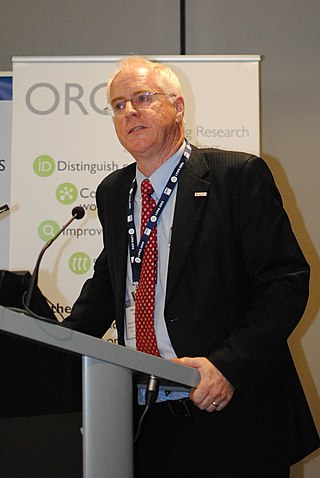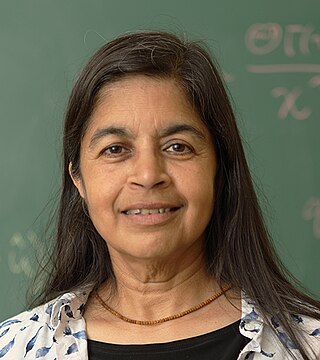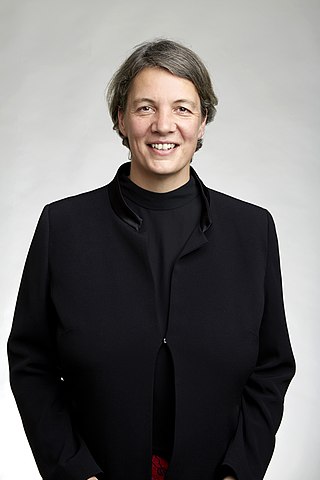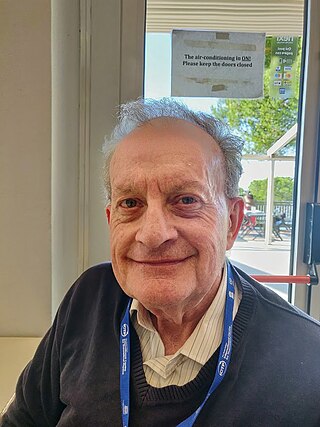The Defence Science and Technology Group (DSTG) is a part of the Australian Department of Defence, which provides science and technology support to safeguard Australia and its national interests. The agency's name was changed from Defence Science and Technology Organisation (DSTO) on 1 July 2015. It is Australia's second largest government-funded science organisation after the CSIRO and its research outcomes have supported operations for over 100 years.

The Australian Academy of Science was founded in 1954 by a group of distinguished Australians, including Australian Fellows of the Royal Society of London. The first president was Sir Mark Oliphant. The academy is modelled after the Royal Society and operates under a Royal charter; as such, it is an independent body, but it has government endorsement. The Academy Secretariat is in Canberra, at the Shine Dome.

Joseph Lade Pawsey was an Australian scientist, radiophysicist and radio astronomer.

Keith Alexander Nugent FAA is an Australian physicist. He is Emeritus Professor of Physics at the Australian National University (ANU) in Canberra.

Martin Andrew Green is an Australian engineer and professor at the University of New South Wales who works on solar energy. He was awarded the 2021 Japan Prize for his achievements in the "Development of High-Efficiency Silicon Photovoltaic Devices". He is editor-in-chief of the academic journal Progress in Photovoltaics.

Brian Paul Schmidt is a Distinguished Professor and astrophysicist at the Australian National University's Mount Stromlo Observatory and Research School of Astronomy and Astrophysics. He was the Vice-Chancellor of the Australian National University (ANU) from January 2016 to January 2024. He is known for his research in using supernovae as cosmological probes. He previously held a Federation Fellowship and a Laureate Fellowship from the Australian Research Council, and was elected a Fellow of the Royal Society (FRS) in 2012. Schmidt shared both the 2006 Shaw Prize in Astronomy and the 2011 Nobel Prize in Physics with Saul Perlmutter and Adam Riess for providing evidence that the expansion of the universe is accelerating.
The Pawsey Medal is awarded annually by the Australian Academy of Science to recognize outstanding research in the physics by an Australian scientist early in their career.

Nalini Joshi is an Australian mathematician. She is a professor in the School of Mathematics and Statistics at the University of Sydney, the first woman in the School to hold this position, and is a past-president of the Australian Mathematical Society. Joshi is a member of the School's Applied Mathematics Research Group. Her research concerns integrable systems. She was awarded the Georgina Sweet Australian Laureate Fellowship in 2012. Joshi is also the Vice-President of the International Mathematical Union, and is the first Australian to hold this position.

Benjamin John Eggleton,, is Pro Vice Chancellor (Research) at the University of Sydney. He is also Professor in the School of Physics where he leads a research group in integrated photonics, nonlinear optics and smart sensors and serves as co-director of the NSW Smart Sensing Network (NSSN).
Anthony William (Tony) Thomas is an Australian physicist, Professor of Physics at the University of Adelaide since 1984 and Elder Professor of Physics since 1990.

Michelle Yvonne Simmons is an Australian quantum physicist, recognised for her foundational contributions to the field of atomic electronics.

Frances Separovic is a biophysical chemist and Distinguished Professor Emeritus of Chemistry at the University of Melbourne, where she taught physical chemistry and trained graduate students in her field. She is credited with developing techniques that utilise nuclear magnetic resonance spectroscopy (NMR) to study peptides in lipid bilayers, with applications in the study of the structure of membrane proteins and their effects on membranes. Her more recent research concerns 'the structure and interactions of amyloid peptides from Alzheimer's disease, pore-forming toxins and antibiotic peptides in model biological membranes'.

Professor Bruce Harold John McKellar is an Australian theoretical particle physicist who is Honorary Professorial Fellow at the Centre of Excellence for Particle Physics at the Terascale (CoEPP) in the School of Physics at The University of Melbourne. The International Union of Pure and Applied Physics (IUPAP) elected him as its President-Designate in 2012. In November 2014 McKellar became President of IUPAP, the first-ever Australian to take on this role.
Nils Göran Arne Roos FTSE is a Swedish academic, technologist, author and businessman. He is a specialist in the field of intellectual capital and an expert in innovation management and strategy. He was appointed Thinker in Residence on industry development by the Government of South Australia in 2011, and subsequently moved to the state's Economic Development Board, where he serves as a member. Amongst a number of other positions, he is also a member of the Flinders University Council. Roos was named one of the 13 most influential thinkers for the 21st century by the Spanish business journal Direccion y Progreso.
Chennupati Jagadish, an Indian-Australian physicist and academic, is the President of the Australian Academy of Science, and a Distinguished Professor of Physics at the Australian National University Research School of Physics. He is head of the Semiconductor Optoelectronics and Nanotechnology Group which he established in 1990. He is also the Convener of the Australian Nanotechnology Network and Director of Australian National Fabrication Facility ACT Node.
Igor Aharonovich is an Australian physicist and materials engineer. He is a professor at the School of Mathematical and Physical Sciences at the University of Technology Sydney (UTS). Igor investigates optically active defects in solids, with an overarching goal to identify new generation of ultra-bright solid state quantum emitters. His main contributions include discovery of new color centers in diamond and hexagonal boron nitride as well as development of new methodologies to engineer nanophotonic devices from these materials.
Marcela Bilek is a Professor of Applied Physics and Surface Engineering at the University of Sydney, Australia. Her research interests focus on the use of plasma related methods to synthesise thin film materials and modify surfaces and interfaces. She was named Fellow of the American Physical Society in 2012 and Fellow of the Institute of Electrical and Electronics Engineers (IEEE) in 2015 for contributions to the science and application of plasma processes for materials modification and synthesis.

Mary Jacquiline Romero is a quantum physicist in the Australian Research Council Centre of Excellence for Engineered Quantum Systems at the University of Queensland, Australia. Her research expertise and interests are in the field of quantum foundations and quantum information. In particular, Romero is an experimental quantum physicist studying the properties of single photons for the development of new quantum alphabets and the nature of quantum causality.
The SA Scientist of the Year is awarded by the South Australian State Government for eminence in science as part of the annual SA Science Excellence and Innovation Awards.
Gregory John Clark is an Australian physicist and business executive. His research focused on the field of high-pressure mineral physics. Subsequently, his business career included senior management roles at News Corporation, Loral Space and Communications, ANZ Banking Group, NextDC, and KaComm Communications. He was awarded the Pawsey Medal in 1979 for his research, and in 2018, he was appointed as a Companion of the Order of Australia.











